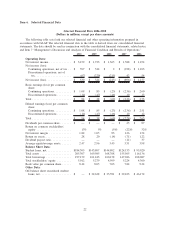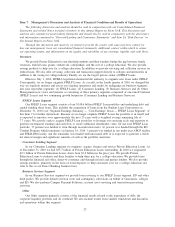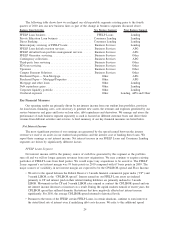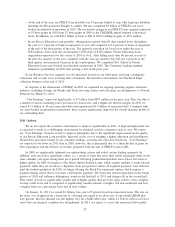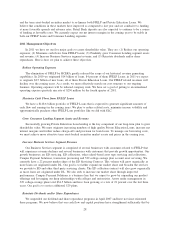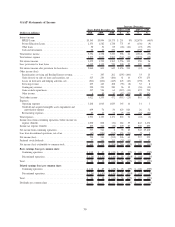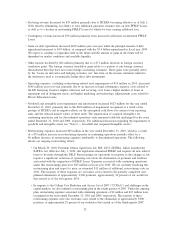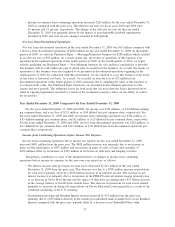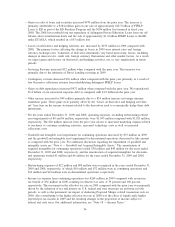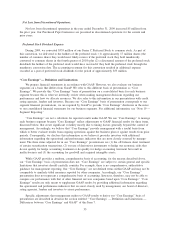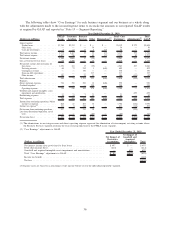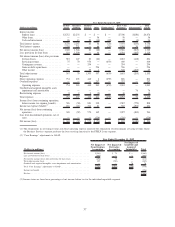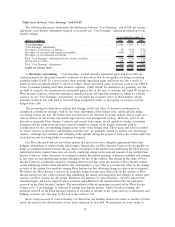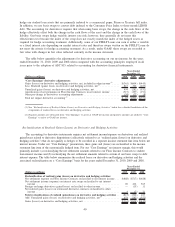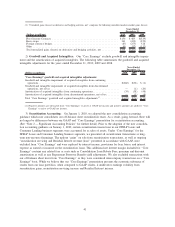Sallie Mae 2010 Annual Report Download - page 33
Download and view the complete annual report
Please find page 33 of the 2010 Sallie Mae annual report below. You can navigate through the pages in the report by either clicking on the pages listed below, or by using the keyword search tool below to find specific information within the annual report.• Servicing revenue decreased by $35 million primarily due to HCERA becoming effective as of July 1,
2010, thereby eliminating our ability to earn additional guarantor issuance fees on new FFELP Loans,
as well as to a decline in outstanding FFELP Loans for which we were earning additional fees.
• Contingency revenue increased $36 million primarily from increased collections on defaulted FFELP
Loans.
• Gains on debt repurchases decreased $219 million year-over-year while the principal amount of debt
repurchased increased to $4.9 billion, as compared with the $3.4 billion repurchased in fiscal year 2009.
We expect to continue to repurchase debt in the future and the amount of gains in the future will be
dependent on market conditions and available liquidity.
• Other income declined by $82 million primarily due to a $71 million decrease in foreign currency
translation gains. The foreign currency translation gains relate to a portion of our foreign currency
denominated debt that does not receive hedge accounting treatment. These gains were partially offset
by the “losses on derivative and hedging activities, net” line item on the income statement related to
the derivatives used to economically hedge these debt instruments.
• Operating expenses, excluding restructuring-related asset impairments of $19 million in 2010, increased
$146 million year-over-year primarily due to an increase in legal contingency expense, costs related to
the ED Servicing Contract, higher collection and servicing costs from a higher number of loans in
repayment and in delinquent status, and higher marketing and technology enhancement costs related to
Private Education Loans.
• Goodwill and intangible asset impairment and amortization increased $623 million for the year ended
December 31, 2010, primarily due to the $660 million of impairment recognized as a result of the
passage of HCERA and its negative effects on the anticipated cash flows for certain of our reporting
units and the reduced market values of these units. The amortization of acquired intangibles for
continuing operations and for discontinued operations each remained relatively unchanged for the years
ended December 31, 2010 and 2009, respectively. For additional discussion regarding the impairment of
goodwill and intangible assets see “Note 6 — Goodwill and Acquired Intangible Assets.”
• Restructuring expenses increased $69 million in the year ended December 31, 2010, which is a result
of a $75 million increase in restructuring expenses in continuing operations partially offset by a
$6 million decrease in restructuring expenses attributable to discontinued operations. The following
details our ongoing restructuring efforts:
• On March 30, 2010, President Obama signed into law H.R. 4872, HCERA, which included the
SAFRA Act. Effective July 1, 2010, this legislation eliminated FFELP and requires all new federal
loans to be made through the DSLP. Restructuring our operations in response to this change in law
requires a significant reduction of operating costs from the elimination of positions and facilities
associated with the origination of FFELP Loans. Expenses associated with continuing operations
under this restructuring plan were $83 million in fiscal year 2010. We are currently finalizing this
restructuring plan and expect to incur an estimated $11 million of additional restructuring costs in
2011. The majority of these expenses are severance costs related to the partially completed and
planned elimination of approximately 2,500 positions, approximately 30 percent of our workforce
that existed as of the first quarter 2010.
• In response to the College Cost Reduction and Access Act of 2007 (“CCRAA”) and challenges in the
capital markets, we also initiated a restructuring plan in the fourth quarter of 2007. Under this ongoing
plan, restructuring expenses associated with continuing operations of $2 million and $10 million were
recognized in the years ended December 31, 2010 and 2009, respectively. The majority of these
restructuring expenses were also severance costs related to the elimination of approximately 3,000
positions, or approximately 25 percent of our workforce that existed as of the fourth quarter 2007.
32


